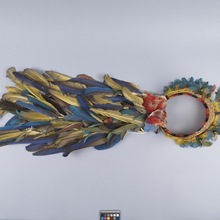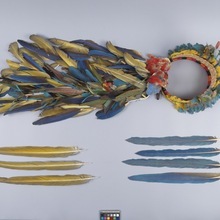Headdress
MOA: University of British Columbia
3010/3 a-h
Headdress of macaw, toucan and parrot feathers. Brim made of woven palm bark, above a strip heavily wrapped with fine wool. On the outside of the brim are two layers of short blue and yellow feathers lying horizontally, with a layer of yellow feathers adhered upright to the woven rim. Behind this are seven upright, long painted tubes into which seven long blue and yellow feathers are inserted (parts b-h). Three bird wings with red and blue feathers are attached at the back of the brim. Below are tied several long strands of fibre, some threaded with small white glass beads. Intermittently down each strand are attached feathers in various sizes, in small groupings gathered at their quills by short lengths of palm tubes. Some strands include dark brown, elongated seeds. Together the strands would create a dense fall, down the back of the wearer.
-
History Of Use
Feather headdresses are a major element of ritual regalia, used during the healing ceremonies of the Kamentsa shamans, as well as for their Carnival ceremony (in which an ancient renewal ritual was adapted onto the Christian calendar event).
- Type of Item headdress
- Culture Kamentsa
- Material toucan feather, parrot feather, macaw feather, glass, palm fibre, bark, wool fibre, bird wing, seed
- Measurements height 64.0 cm, width 49.0 cm, depth 114.0 cm (overall) height 25.5 cm, width 49.0 cm, depth 114.0 cm (part a) height 45.5 cm, width 4.6 cm (part b) height 39.5 cm, width 4.0 cm (part c)
- Creator Basilio Juajibioy
- Previous Owner Diego Samper, Marlene Samper
- Received from Diego Samper, Museum of Anthropology Director's Budget
- Made in Putumayo
- Creation Date before 1989
- Collection Date during 1989
- Ownership Date before August 4, 2013
- Acquisition Date on August 4, 2013
- Condition fair
- Accession Number 3010/0003 a-h



